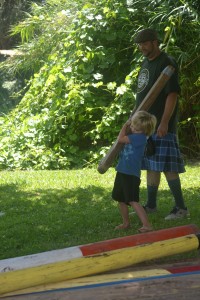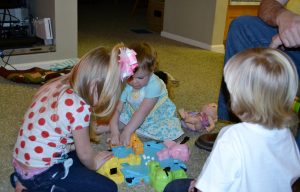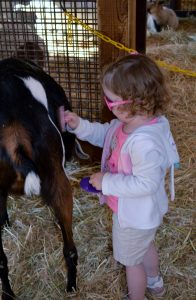with dark eyes and a curly brown ponytail catches my attention. Anything is more interesting than a magazine a few years old that no one has bothered to steal yet. The girl whispers a secret in her friend’s ear; they both giggle.
Anticipating an afternoon playing together, the mother casually inquires, “What do you want for lunch?”
Their faces beam as they simultaneously declare, “McDonald’s!”
Of course they want McDonald’s. What kid doesn’t?
“Well, we’re going to have leftovers from last night,” the mother casually comments.
The girls’ smiles fade.
No Intention
Leftovers, I ponder. Who wants leftovers when you think you’re going to get McDonald’s? My joy observing the girls dwindles. Another parent giving children a choice while she never intends to let them choose. It won’t be the last time I witness this dilemma.
In my last blog post, At What Age? the key question was, how are you intentionally allowing your child to make increasingly more choices and God honoring decisions as he or she launches into adulthood? Today we’ll explore giving children choices, benefits of choices, and building basic decision making skills.
Making Choices
Learning to make choices actually begins in toddlerhood. Parents and caregivers can offer simple, either-or choices to children. “Do you want to wear the blue shirt or the green shirt?” “Would you like yogurt or applesauce for snack?” Even toddlers can point to what they want. “Choices offered to young children must be legitimate and meaningful to them and acceptable to adults,” explains Dr. Sue Grossman in Early Childhood News. 1
Follow Through
Don’t give a choice if you don’t intend to follow through. The mother in the waiting room could have stated, “We have leftover casserole and macaroni salad for lunch today. Would you girls like to eat lunch outside on a picnic blanket or in the kitchen after our appointment?”
Simple Choices
In preschool, children can begin choosing from more than two options. My four-year-old grandson loves grocery shopping with Grams. Besides organizing the shelves, he proudly selects juice from a number of varieties or yogurt flavors. “Limiting the quantity of choices is actually helping your child be successful in the decision-making process,” notes Dr. Alexandra Delis-Abrams, author of Children, Choices, and Consequences. 2
Avoiding “NO”
In an effort to increase children’s choices, sometimes parents give children more choices than they’re developmentally ready for or are beyond their cognitive abilities. For example, “Do you want to go to bed now?” will most assuredly be answered, “No.” Where do you want to go on vacation may be answered, “Disneyland!” while you’re planning on a camping budget.
Contribute to Choices
Children do not get to make every choice, however, within many parent-made decisions, children can still contribute to choices. “Next week we’re going on a family campout. Do you want to go fishing, boating, hiking or swimming on Saturday?” “Do you want me to read you a story or would you like to read for ten minutes on your own before the lights go out?” Our daughters became so accustomed to making choices, that sometimes our response was, “This is not, Let’s Make a Deal. This is a parent decision.”
Choosing Activities
As children enter elementary school, helping them determine outcomes of choices becomes imperative. “I want to play soccer this year,” our six-year-old daughter shares. “It looks like fun.” But what does she really know about being on a soccer team? “Too many times a child is given the power to make the decision without the information first,” notes the founder of ABC Feelings. 2
Engaging Questions
Does my daughter understand that she must practice three times a week? Does she recognize that a coach will be teaching her how to play? What does she comprehend about teamwork, winning, and losing? Have we explained that if she chooses to play she’s expected to complete the twelve-week season? Although this may sound overwhelming for children, this discussion develops reasoning skills and accepting personal responsibility for choices which will serve them well for a lifetime.
Problem Solving
Helping school-age children determine possibilities before adolescence is invaluable and builds strong problem-solving foundations. Asking situational questions like, “What would you do if a stranger asked you to help him find his kitty?” to “What do you think about the decision Joey made on TV last night?” require critical thinking skills. Setting up situational scenarios and asking thought-provoking questions play a critical role in adolescence when the stakes are higher and the costs are greater.
“You are capable.”
Allowing children to make choices helps them developmentally in several ways. Children build autonomy, a fancy word for independence. Adults make so many decisions for children, that when children get to choose they possess a sense of control. They feel validated when parents and other adults send the message, “You are capable. What you say is important and matters.” Training in problem solving empowers children for future decision-making. Children are more committed when they’ve made the choice for themselves.
Fond Memories
Our daughter chose soccer year after year. She even played a few winter sessions in the mud and rain, her favorite way to play. When my husband and I see children in soccer uniforms on fall Saturday mornings, it brings back fond memories…. watching her valiantly defending the goal, her excitement when she wins, and forming strong friendships. Then we remember the year she chose not to play soccer. And that’s another story.
Sources:
1. Dr. Sue Grossman, Ph.D. Offering Children Choices: Encouraging Autonomy and Learning While Minimizing Conflict, Early Childhood News. www.earlychildhoodnews.com/earlychldhood/article_print.aspx.
2. Alexandra Delis-Abrams, Ph.D. Children, Choices, and Consequences. www.abcfeelings.com
3. Image: hamburger [pxhere.com_en_photo_1556149]


 choices, like work requirements. Children need to learn that they don’t always have a choice. Sometimes decisions are made by parents or other adults.
choices, like work requirements. Children need to learn that they don’t always have a choice. Sometimes decisions are made by parents or other adults.



 While reading the latest magazine and waiting for an x-ray at the busy clinic, an eight-year-old girl
While reading the latest magazine and waiting for an x-ray at the busy clinic, an eight-year-old girl

